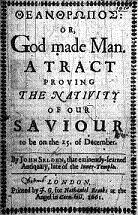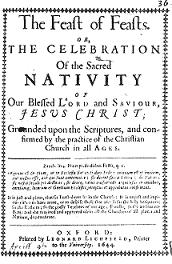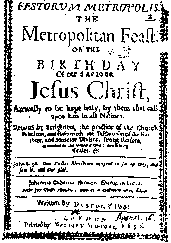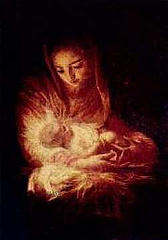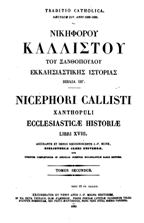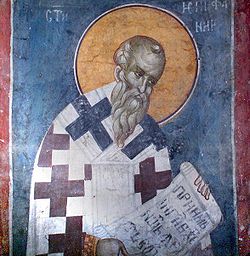Commentary on Matthew
- Chapter One -
Jesus’ Genealogical Credentials as Heir of the World and the Davidic
Throne.
1 - The book of the generation of Jesus Christ,
The identical phrase
the book of the generation
occurs in Genesis 5:1, where it introduces a list of Adam's
descendants beginning with Seth through nine generations, to
Shem, Ham, and Jepheth, the sons of Noah (Gen. 5:32). The table
is not a comprehensive list of Adam's descendants, but
represents the sacred seed-line through which God would bring
the Redeemer into the world. Following the fall of our first
ancestors, God promised to save his people and defeat the power
of sin and death:
"And the Lord God said unto the serpent, Because thou hast done
this, thou art cursed above all cattle, and above every beast of
the field; upon thy belly shalt thou go, and dust shalt thou eat
all the days of thy life: And I will put enmity between thee and
the woman, and between thy seed and her seed; it shall bruise
thy head, and thou shalt bruise his heel." Gen. 3:14-16
This promise, called the
protevangelium, is the
earliest announcement of the gospel of Christ. The
woman stands for the
people of God, the faithful seed embodied in by the covenant
community. The serpent
is the enemy of God's people, first and foremost, the power of
sin and death, but by extension, the sons of disobedience, which
persecuted the people of God, particularly as these came to be
identified in the opposing world civil power (
By using language recalling the book of
Adam's sacred heirs, Matthew signifies that the seed-line of
man's salvation culminates in the birth of Jesus Christ.
the son of David, the son of Abraham.
The genealogical descent of the sacred
seed-line from Adam to the sons of Noah resumes in Gen.
10:10-32, which gives an account of the descendants of Shem to
Abraham (nine generations). The heirs to the promise are
usually, though not invariably, firstborn sons. The election, by
which the promise descended, was according to God's sovereign
choice, and "not of him
that willeth, nor of him that runneth, but of God that sheweth
mercy" (Rom.
Matthew places the names of David and
Abraham at the head of his genealogical account because these
two names sum up in an instant the distinct claims of Christ: As
son of David he was heir to the Davidic throne; as the son of
Abraham he was the promised seed who was heir of the world (Rom.
4:13).
2 - Abraham begat Isaac; and Isaac begat Jacob; and Jacob begat Judas
and his brethren.
Luke (e.g., Lucas abbreviated from Lucanus) was a Gentile and addressed
his gospel to a Gentile named Theophilus (Lk. 1:3; Acts 1:1). It
is therefore natural in giving the genealogy of Christ that Luke
traced Jesus' descent to Adam, showing his common humanity with
the whole race of men and that he is the Savior of all mankind.
Matthew, however, was a Jew and composed his gospel as we might
expect a Jew, concerned to demonstrate how Jesus fulfilled the
promises of which the Jewish nation was steward (cf. Rom. 9:4). Matthew therefore confines himself to proof of Jesus'
descent from Abraham. The first series of names covers four
generations, from Abraham to
The
sceptre shall not depart from
The term
3 - And Judas begat Phares and Zara of Thamar; and Phares begat Esron;
and Esrom begat
4 - And
Abraham was seventy five when he entered
"They left Egypt in the month Xanthicus, on the fifteenth day of the
lunar month; four hundred and thirty years after our forefather
Abraham came into Canaan, but two hundred and fifteen years only
after Jacob removed into Egypt" Ant. II, xv, 2
God told Abraham that his seed would be
servants in a strange land and come out in the fourth generation
(Gen. 15:13-16). Nahshon is listed as one of the heads of the
tribes of
5, 6 - And Salmon begat Booz of Rachab; and Booz begat Obed of Ruth; and
Obed begat Jesse. And Jesse begat David the king; and David the
king begat Solomon of her that had been the wife of Urias.
The chief difficulty of these verses is the
distance of time spanned by six generations. Solomon began
building the temple in the four-hundred-eightieth year after the
children of
It is remarkable that, in mentioning David
and Solomon, the two principal types of the Messiah, there
should also occur the names of women whose mention calls to mind
our fallenness and sin. By woman sin entered into the world; and
by woman came the Redeemer of mankind.
7 - And Solomon
Matthew introduces his genealogy saying,
"the book of the
generation of Jesus Christ, the son of David." The first son
of David in the kingly line was Solomon; Jesus Christ was the
last. After David, Solomon is the leading type and foreshadow of
Christ. God promised David:
"And when thy days be fulfilled, and thou shalt sleep with thy
fathers, I will set up thy seed after thee, which shall proceed
out of thy bowels, and I will establish his kingdom. He shall
build an house for my name, and I will stablish the throne of
his kingdom for ever. I will be his father, and he shall be my
son." II Sam. 7:12-14
Here we find God's promise that Christ
would come from the seed
of David, that God would be his
father, and that his
throne and kingdom (dominion) would
last forever. In their immediate historical context, these promises
found a certain fulfillment in Solomon, whose greatness, wealth,
and wisdom prefigured Christ, who was their ultimate object.
"All the kings of Arabia and the governors of the country
brought gold and silver to Solomon…and all the kings of the
earth sought the presence of Solomon, to hear his wisdom, that
God put in his heart"…And he reigned over all the kings from the
river even unto the land of the Philistine, and to the border of
Egypt." (II Chron. 9:14, 23, 26; cf. Ps. 72).
The typological nature of Solomon's reign,
and the prediction that the Messiah would reign
"unto the ends of the
earth" (Ps. 72:8; cf.
Dan. 7:27), caused Jewish expectation to see Christ as a
national liberator, who would sit on David's throne in earthly
Jerusalem, vanquish Israel's enemies, and raise her to world
power. On one occasion, this misapprehension led the Jews to
attempt take Jesus by force and make him king (Jn.
begat Roboam; and Roboam begat Abia; and Abia begat Asa.
David reigned forty years over
8 - And Asa begat Josaphat; and Josaphat begat Joram; and Joram begat
Ozias.
This verse presents a gap in the succession
of kings and Matthew's genealogy. Jehoshaphat reigned
twenty-five years in
The omission of these kings involves
neither deception nor error, but probably reflects a Jewish
convention that was loath to give their names in the succession
of the kings of
9 - And Ozias begat Joatham; and Joatham begat Achaz; and Achaz begat
Ezekias.
Ozias is the Greek spelling of Uzziah;
Uzziah reigned fifty-two years (II Chron. 26:3). Jotham reigned
sixteen years (II Chron. 27:1). Ahaz reigned sixteen years (II
Chron. 28:1), and Hezekiah reigned twenty-nine years (II Chron.
29:1). This verse thus spans the period of
one hundred thirteen years.
It was during the reigns of these kings that Isaiah prophesied
(Isa. 1:1), and we first read of the Assyio-Babylonian
invasions. In the sixth year of Hezekiah, the ten northern
tribes were carried in captivity by the Assyians (II Kng. 17:1,
6; II Kng. 18:9, 10). The Assyrians also invaded
10 - And Ezekias begat Manasses; and Manasses begat Amon; and Amon begat
Josias.
Manesseh reigned fifty-five years (II
Chron. 33:1). Amon reigned two years (II Chron. 33:21). Josiah
reigned thirty-one years (II Chron. 34:1). From Manasseh through
Josiah thus covers a period of
eighty-eight years.
11 - And Josias begat Jechonias and his brethren, about the time they
were carried away to
Josiah had four sons: Jehoahaz, Jehoiakim,
Zedekiah, and Shallum. Jehoahaz was carried into captivity and
died in Egypt without issue (II Kng.
|
Name: |
|
Length of Reign |
|
History
|
|
Josiah |
|
31 years |
|
Slain in battle by Pharaoh Necho |
|
Jehoahaz: |
|
3 months |
|
Carried by Pharaoh Necho into
captivity in |
|
Jehoiakim: |
|
11 years |
|
Rebelled against Babylonians; was
executed by Nebuchadnezzar, who made Jehoiakim's son,
Jehoiachin (Coniah), king instead. |
|
Jehoiachin (Coniah, Jeconiah): |
|
3 months, 10 days |
|
Carried into captivity in |
|
Zedekiah: |
|
11 years |
|
Rebelled against Nebuchadnezzar,
was captured, his sons slain without issue, and was
carried captive into |
Since three out of four of Josiah's sons
reigned as king, when Matthew says
Josiah begat Jeconiah
and his brethren
about the time they were carried away into Babylon, it seems
clear it is Jehoiakim and his brethren that are actually
referred to. This is especially evident when it is borne in mind
that Jeconiah was the only son of his father and had no
brethren. The question thus becomes, why is Jeconiah named in
place of his father Jehoiakim? We believe it is because
Jehoiakim is numbered among the
execrated kings of
Jehoiakim “did that which was evil in the
sight of the Lord, according to all that his fathers had done”
(II Kng.
12 -
And after they were brought to
Beginning with the Babylonian captivity,
"And thou, profane wicked prince of Israel, whose day is come,
when iniquity shall have an end, thus saith the Lord God: Remove
the diadem, and take off the crown: this shall not be the same.
Exalt him that is low, and abase him that is high. I will
overturn, overturn, overturn, it: and it shall be no more, until
he come whose right it is; and I will give it him." Ezek.
21:25-27
From the Babylonian captivity until the birth of Christ, the house of David was like a tree cut down, leaving only a stump. But the root of Jesse would put forth a rod and bud:
"And there shall come
forth a rod out of the stem of Jesse, and a Branch shall grow
out of his roots:
And the spirit of the
Lord shall rest upon him, the spirit of wisdom and understanding, the spirit
of counsel and might, the spirit of knowledge and of the fear of
the
Lord;
And shall make him of
quick understanding in the fear of the
Lord:
and he shall not judge after the sight of his eyes, neither
reprove after the hearing of his ears:
But with righteousness
shall he judge the poor, and reprove with equity for the meek of
the earth: and he shall smite the earth: with the rod of his
mouth, and with the breath of his lips shall he slay the wicked.
And righteousness shall be
the girdle of his loins, and faithfulness the girdle of his
reins." Isa. 1:1-5
Jechonias begat Salathiel;
Matthew has arranged his genealogical account in three sets of fourteen generations (v. 17). Jeconiah appeared in place of his father above, and a Jeconiah appears again here. However, these are not the same man; otherwise, Matthew would be guilty of counting the same man twice, negating his scheme of three sets of fourteen generations. The Jeconiah of this verse is actually Zedekiah, the son of Jeconiah. This is clear from the genealogy of I Chronicles:
"And the sons of Josiah
were, the firstborn Johannan, the second Jehoiakim, the third
Zedekiah, the fourth Shallum. And the sons of Jehoiakim:
Jeconiah his son, Zedekiah his son. And the sons of Jeconiah,
Assir, Salathiel his son, Malchiram also, and Pedaiah, and
Shenazar, Jecamiah, Hoshama, and Nedabiah."
I Chron.
Here we see
that the succession of the seed-royál followed Josiah,
Jehoiakim, Jeconiah, Zedekiah, and Salathiel. But where we would
expect Zedekiah to be named in the generation following
Jeconiah, the son of Jehoiakim, the name Jeconiah appears a
second time instead. But this must be understood as Zedekiah by
another name and not the same man twice, for it was common among
the kings and royal family to have more than one name. Thus,
Johoahaz is called Johannan and Shallum (I Chron. t1:time
Hour="15" Minute="15" w:st="on">3:15; Jer.
and
Salathiel begat Zorobabel.
There is an apparent discrepancy between Matthew and Chronicles. Matthew says Zerubbabel was the son of Salathiel, but Chronicles say he was the son of Pedaiah.
And
the sons of Jeconiah, Assir, Salathiel his son, Malchiram also,
and Pedaiah, and Shenazar, Jecamiah, Hoshama, and Nedabiah. And
the sons of Pedaiah were, Zerubbabel, and Shimei: and the sons
of Zerubbabel, Meshullam, and Hannaniah, and Shelomith their
sister: And Hashubah, and Ohel, and Berechiah, and Hasadiah,
Jushabhesed, five."
I Chron. 3:17-20
The solution here again doubtless is a
levirate marriage, in which Pedaiah died without issue and
Salathiel married his brother's widow, similar to Boaz who
married Ruth, so that Chronicles attributes Zerubbabel to
Pediahah, but Matthew gives the name Salathiel instead. Matthew
is corroborated by Ezra, the prophet Haggai, and Luke, who also
call Zerubbabel the son of Shealtiel (Ezra 3:2; 5:2; Haggai
1:1,14; 2:2; Lk. 3:27).
13 -
And Zorobabel begat Abiud; and Abiud begat Eliakim; and Eliakim
begat Azor.
Zerubbabel was the governor who, together
with Joshua the high priest, brought again the captivity out of
The names following Zerubbabel in
Chronicles disagree with those in Matthew. Chronicles attributes
eight children to Zerubbabel, seven sons and one daughter:
Meshullam, Hananiah,
Shelomith (their sister), Hashubah, Ohel, Berechiah, Hasadiah,
and Jushabhesed (I Chron.
14 -
And Azor begat Sadoc; and Sadoc begat Achim; and Achim begat
Eliud.
We here enter the intertestamental period
between the close of the Old Testament canon and the opening of
the New Testament. This was a period of prophetic silence,
during which there were no prophets or prophetic utterances and
heaven seemed shut up against man, as if to make the miracles of
Christ and the apostles the more glorious and pronounced when
once the heavens opened again, attesting that Jesus is the Son
of God.
15,
16 - And Eliud begat Eleazar; and Eleazar begat Matthan; and
Matthan begat Jacob; and Jacob begat Joseph the husband of
Matthews says that Jacob
begat Joseph, but Luke
calls Joseph the son of
Heli (Eli) (Lk.
Mary, of whom was born Jesus, who is called Christ.
17 -
So all the generations from Abraham to David are fourteen
generations; and from David until the carrying away into
Matthew enumerates three sets of fourteen
generations
("tesseradecads") from Abraham until Christ. As we have
seen, these are not strictly literal, but contain several
omissions. They represent sets of
mentionable
(non-execrated) names, symmetrically arranged in equal parts to
aid memorization - "three
sets of fourteen, plus four" ( the four kings omitted being
Ahaziah, Joash,
Amaziah, and Jehoiakim) - the
omission of certain names being understood and accepted by all
in accordance with Jewish convention. The absolute reliability
of Matthew's account of Jesus' descent and claim to the Davidic
throne is admitted even by the Jews. Rabbi Ulla (circa A.D. 210) says "Jesus
was exceptionally treated because of royal descent."[7] This
royal descent was publicly known and acknowledged by the Romans
in the time of Domitian, who gave orders for the execution of
the royal family of David, but, having examined the grandsons of
Jude, the brother of the Lord, dismissed them as harmless,
simple folk.[8]
If we tally the years until the birth of
Christ, the sum of the above will be as follows:
From the birth of Abraham to
From entering
From the Exodus until the beginning of
David's reign………….…………...…..552 years
From David until the Babylonian captivity (586 B.C.).…………...……....…..452 years
From the captivity until the birth of Christ (2
B.C.)………....…………………...584 years
Total…..2093 years
And from Noah to
Abraham…...…………………………………………...............……952 years[10]
Total…4101
years
Having provided an account of Jesus'
genealogical descent and claim to the Davidic throne, Matthew
proceeds to the circumstances of his birth, which, no less than
his ancestral descent, give full evidence that Jesus is the
Christ of prophetic promise.
When
as his mother Mary was espoused to Joseph, before they came
together,
According to Jewish law and tradition,
betrothal or espousal was equal to marriage in all points except
consummation and sexual intimacy. The couple's espousal was
solemnized by covenant and oath just as in a marriage ceremony,
but instead of the nuptials following immediately, there was
instead a betrothal period of approximately one year - enough
time for the bride's purity to be demonstrated; for if she were
pregnant with another man's child, it would become evident
during this period. The couple did not cohabitate as is
sometimes asserted, for if the bride was found to be pregnant,
this would expose the husband to a charge that the child was in
fact his own. And since impurity in the bride was equal to
adultery and might be punished capitally, every precaution was
made to preserve the bride's chastity from all suspicion and
accusation. The shame and peril associated with the charge of
being unchaste, which Mary freely undertook to bring Christ into
the world, anticipated Jesus' shame in the cross, who
"was made sin for us, who
knew no sin, that we might be made the righteousness of God in
him" (II Cor. 5:21).
she
was found with child of the Holy Ghost.
The details of Mary's conception are not
provided. For these we must turn to Luke, who tells of the
visitation of Gabriel and the Annunciation (Lk.
19 -
Then Joseph her husband, being a just man, and not willing to
make her a publick example, was minded to put her away privily.
Legal standing to bring a charge of
adultery seems to have belonged solely to the husband; the state
appears to have had no jurisdiction or authority to prosecute a
complaint in its own right where the husband decided not to act.
The husband at his election might bring a public charge;
punishment would then entail stoning at the door of her father's
home, since while she was in his house she was under his
coverture (authority and protection, as implied by the veil, I
Cor. 11:1-16), and he must therefore share the blame for not
having adequately safeguarded her purity and conduct
(Deut. 22:13-21). The guilty man was also to be put to
death (Deut.
20 -
But while he thought on these things, behold, the angel of the
Lord appeared unto him in a dream, saying, Joseph, thou son of
David, fear not to take unto thee Mary thy wife: for that which
is conceived in her is of the Holy Ghost.
The Davidic throne had been unoccupied for
almost six hundred years; the house of David had fallen into the
utmost meanness and poverty; his descendants reduced to country
peasants and simple artisans; descent from David must have
seemed a mere curiosity, an irrelevancy, just as it would be to
claim today descent from a medieval monarch. Yet, the angelic
announcement revives the hope of
21 -
And she shall bring forth a son,
The prophecy of Isaiah seems particularly
appropriate here:
"For
unto us a child is born, unto us a son is given: and the
government shall be upon his shoulder: and his name shall be
called Wonderful, Counseller, The mighty God, The everlasting
Father, The Prince of Peace. Of the increase of his government
and peace there shall be no end, upon the throne of David, and
upon his kingdom, to order it, and to establish it with judgment
and with justice from henceforth even for ever. The zeal of the
Lord of hosts will perform this." Isa. 9:6, 7
The name
Jesus means "savior."
It is the Greek form of the Aramaic
Yeshua or the more
familiar Anglicized version
Joshua. The Holy Ghost
chose to reveal the Savior to the Gentile world by the Greek
name Jesus, even
though his family would have known him by the Aramaic
Yeshua. But as the
Aramaic form would be a word without meaning to the Greek
speaking world of the day, the Greek form was chosen to make
clear that Christ's mission was
to save man from sin.
22,
23 - Now all this
was done, that it might be fulfilled which was spoken of the
Lord by the prophet, saying, Behold, a virgin shall be with
child, and shall bring forth a son,
The virgin birth of Christ is firmly
attested and an essential element of the Christian faith. When
God created Adam, he made him in his own image and likeness
(Gen. 1:26), which is best understood in terms of man's moral
faculties and ability to demonstrate the fruits of the Spirit
(Gal. 5:22, 23). Man's ability to live above the flesh depended
upon the indwelling of God's Spirit, breathed into man at his
creation (Gen. 2:7). This indwelling and inspiration meant that
man supernaturally
inclined to the things of the Spirit. But with the fall of our
first ancestors, the indwelling of the Spirit was lost, and man
became subject to his carnal nature; he inclined naturally to
the things of the flesh. Adam's children were made in his image
and likeness after his fall (Gen. 5:3), and therefore did not
inherit the original state and condition of goodness and
innocence Adam was created with. Rather, they inherited his
fallen, carnal nature. This does not mean, nor do we believe
scripture teaches, that God
imputed Adam's transgression to his heirs, or that babies and little
children are in need of salvation.
"The soul that sinneth, it
shall die. The son shall not bear the iniquity of the father,
neither shall the father bear the iniquity of the son" (Ezek.
"For
we know that the law is spiritual, but I am carnal, sold under
sin. For that which I do
I allow not: for what I would, that do I not; but what I hate,
that do I…I find then a law, that, when I would do good, evil is
present with me. For I delight in the law of God after the
inward man: but I see another law in my members, warring against
the law of my mind, and bringing me into captivity to the law of
sin which is in my members. O wretched man that I am! Who shall
deliver me from the body of this death? I thank God through
Jesus Christ our Lord."
Here we have Paul's description of man's
hopeless inability to satisfy the law, even though he consents
that it is good and aspires to satisfy its demands. This is the
unhappy lot of all Adam's natural descendants. Since man's
Savior had to be the blameless and spotless Lamb of God, it is
impossible that he should have been born into the world by
normal procreative process; for if he had, he would have
inherited our fallen nature, and suffered the same debilitating
effects described by Paul. Hence, the virgin birth was essential
to man's salvation and is therefore a foundational tenet of the
Christian faith.
Thus far the doctrinal basis underlying the
virgin birth, what does the text and language of scripture
state? There are two terms rendered
virgin in the Old
Testament; one implies
virginity, the other
expressly declares it. The term used by Isaiah is the Hebrew
almah, which Strong's
defines as "a lass,
damsel, maid, or virgin." The common factor in all these is
the subject's age,
from which virginity is
naturally implied. The other term is the Hebrew
bethuwliym, which
Strong's defines as "a
virgin; sometimes (by continuation)
a bride; also (fig.) a
city or state: -
maid, virgin." As
between these two, the latter is the more specific. But Isaiah
used almah, not bethuwliym, and
this has given occasion for some to impugn the virgin birth,
claiming that the prophecy affirms only that a
young woman would
conceive.
The reason Isaiah used
almah and not
bethuwliym is that his
prophecy had both an immediate historical application, and
another that was messianic; the one was fulfilled in Isaiah's
day, the other in Christ. Isaiah's prophecy of the virgin birth
was given in the days of king Ahaz, when
"Behold, a virgin shall conceive, and bear a son, and shall call
his name Immanuel. Butter and honey shall he eat, that he may
know to refuse the evil, and choose the good. For before the
child shall know to refuse the evil, and choose the good, the
land that thou abhorrest shall be forsaken of both her kings."
Isa. 7:14-16
"And
I went to the prophetess; and she conceived, and bare a son.
Then said the Lord to me, Call his name Ma-her-shal-al-hash-baz.
For before the child shall have knowledge to cry, My father, and
my mother, the riches of Damascus and the spoil of Samaria shall
be taken away before the king of Assyria." Isa. 8:3, 4
When we come to the New Testament, we find
that Matthew translated the Hebrew
almah by the Greek
parqenoj. This is the Greek word for
a virgin, and is the
root of the word Parthenon,
the Greek temple devoted to the virgin goddess, Dianna. Matthew
follows the Septuagint, which also used the term
parqenoj to translate Isa. 7:14. Thus, Jews several
hundred years before Christ took
almah, not in the sense of merely a young woman, but a
virgin. Therefore, the
virgin birth is firmly fixed in both doctrine and text.
and
they shall call his name Emmanuel, which being interpreted is,
God with us.
Here we find another aspect spread before
us that gazes beyond Isaiah's son to the birth of Christ. The
name given the child in Isa. 7:14 does not correspond with the
child named Ma-her-shal-al-hash-baz, and is further evidence that the prophecy
had a double signification.
Ma-her-shal-al-hash-baz
spoke distinctly to the historic situation confronting Judah and
Ahaz; Immanuel looked
ahead to the incarnate God. St. Paul says that Christ, though
"being in the form of God,
thought it not robbery to be equal with God, but made himself of
no reputation, and took upon him the form of a servant, and
was made in the likeness
of men" (Phil. 2:6, 7). The phrase "thought
it not robbery to be equal with God" has perplexed many, and
caused the translators of the Revised Standard Edition (RSV) to
wrest the Greek to obtain what they supposed to be Paul's
meaning (even if not his language). Hence the RSV renders the
passage, saying, Christ
"did not count equality with God a thing to be grasped"; but
this misses the point entirely. What Paul is saying instead is
that Christ did not consider his equal part in the Godhead a
thing gotten by robbery,
properly requiring that it be laid aside. To the contrary,
Christ's divinity was fully and properly his own, and his only
compulsion to assume our humanity was that he might redeem us to
God. "For God was in Christ, reconciling the world to himself" (II Cor.
24 -
Then Joseph being raised from sleep did as the angel of the Lord
had bidden him, and took unto him his wife.
Setting aside all doubts and concerns about
Mary's purity, Joseph obeys the Lord's command to take Mary as
his wife. The divine message was not merely to give assurance to
Joseph, or for Mary's sake and reputation. Joseph had a critical
role to play in the divine plan, by lending his royal lineage
and claim to the Davidic throne to Christ. Taking Mary as his
wife also served to legitimize Jesus' birth in the public eye.
Mary would have given birth whether Joseph married her or not,
but Jesus' future ministry would have been greatly hindered if
it was rumored that he was illegitimately conceived and born. It
was necessary that the stainless and pure Lamb of God not seem
to bear any blemish or mark of sin, which could not be the case
without Joseph standing in as his earthly father.
25 -
And knew her not till she had brought forth her firstborn son:
The natural inference of this verse is that
Joseph and Mary engaged in normal conjugal relations following
the birth of the Christ child. Although the word "till" does not
require this conclusion, it seems unavoidable nevertheless as
its inclusion would otherwise be meaningless. What purpose could
be served in saying the couple did not have conjugal relations
until the birth of Christ, if in fact they never had them at
all? Numerous passages speak of Jesus' brothers and sisters in
connection with Joseph his father and Mary his mother:
"Is
not this the carpenter's son? Is not his mother called Mary? And
his brethren, James, and Joses, and Simon, and Judas? And his
sisters, are they not all with us? Whence then hath this man all
these things?" Matt. 13:55-56; cf. Mk. 6:3; Acts 1:12-14; Gal.
1:10
and
he called his name JESUS.
Naming the child usually occurred at the
child’s circumcision, and was an event attended by close friends
and family members (Lk. 1:58-63). The father’s naming the child
would have also served as public ownership of paternity.
Joseph’s naming the child indicates his adoption of Jesus,
holding him out as his own.
[1] The Greek
spelling of names found in the manuscripts is preserved
by the translators; hence Judas =
[2]
See Isa. 8:6 where
Siloah or
Siloh is
rendered in the Septuagint
apestalmenoj,
sent fourth.
Clarke in loc.
[3] Athaliah
is called the
daughter of Omri in II Chron. 22:2, but this is
understood in the sense of a descendant (e.g.,
grand-daughter), in the same way that Jehoshaphat could
be called the son
of David (II Chron. 17:3). Ahab was the son of Omri
(I Kng. 16:28).
[4] The term
levirate is
not from the tribe of Levi as is sometimes supposed, but
from the Latin levir for "one's husband's
brother."
[5] Succession
followed the father. Mary's mother may have been of the
house of Aaron and have married into the family of
David, making Mary of the house of David, but the
children of Mary's uncle, the brother of Mary's mother,
[6] See Eusebius'
Ecclesiastical History where a letter by Julius
Africanus proposed this very thing with slight
variation, representing it to have been preserved by the
desposyni, or
descendants of the holy family (Eccl.
Hist. I, vii).
[7] T.B.
Sanhedren 43a,
[8] Eusebius,
Eccl. Hist.
[9] Adam begat Seth
when he was 130 (Gen. 5:3); Seth begat Enos when he was
105 (Gen. 5:6); Enos begat Cainan when he was 90 (Gen.
5:9); Cainan begat Mahalaleel when he was 70 (Gen.
5:12);
Mahalaleel begat Jered when he was 65 (Gen. 5:15); Jered
begat Enoch when we was 162 (Gen. 5:18); Enoch begat
Methuslelah when he was 65 (Gen. 5:21); Methuselah begat
Lamech when he was 187 (Gen. 5:25); Lamech begat Noah
when he was 182 (Gen. 5:28); the sum of which equals
1056 years.
[10]
Noah was 500 when he begat Shem, Ham, and Jepheth
(Gen. 5:32). The flood came in the 600th year of Noah's
life, and prevailed for a full year and ten days (Gen.
7:11; 8:14). Shem was 100 when he begat Arphaxad two
years after the flood (Gen. 11:10); Arphaxad was 35 when
he begat Salah (Gen. 11:12); Salah was 30 years when he
begat Eber (Gen. 11:14); Eber was 34 when he begat Peleg
(Gen. 11:16); Peleg was 30 when he begat Reu (Gen.
11:18); Reu was 32 when he begat Serug (Gen. 11:20);
Serug was 30 when he begat Nahor (Gen. 11:22); Nahor was
29 when he begat Terah the father of Abraham (Gen.
11:24). Terah was 70 when he “begat Abram, Nahor, and
Haran” (Gen. 11:26). However, as Abraham was 75 when his
father Terah died at the age of 205 (Gen. 11:32; 12:4),
Terah would have 130 at Abraham's birth. Hence, Gen.
11:26 seems to contemplate Terah’s age when he had his
first-born son, probably Haran, and not when all three were born. If
this is correct and Terah was 130 at Abraham’s birth,
the sum of these figures is 950 years. But as Gen. 11:26
appears to reverse the order of birth, placing Abram
first even though he must in fact have been the
last-born son, this may affect the way we understand Gen. 5:32 and
Noah’s three sons, so that Shem, like Abraham, was
probably the
last-born son when Noah was 502. This would explain
how Shem could be 100 two years after the flood. For if
Shem was born when Noah was 500 and the flood came in
the 600th year of Noah’s life, Shem could not
be 100 two years after the flood. If this is correct, the
total from Noah to Abraham would then be 952 years..
[11]
Protoevangelium of
James, 7-9. The notion that Joseph was an old man is
apparently intended to buttress the virgin birth;
e.g., Joseph
is impotent and unable to consummate the marriage.
______________________________
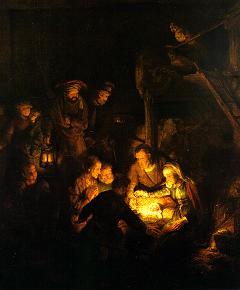
Adoration of the Shepherds
All rights reserved.
 John Seleden’s
John Seleden’s